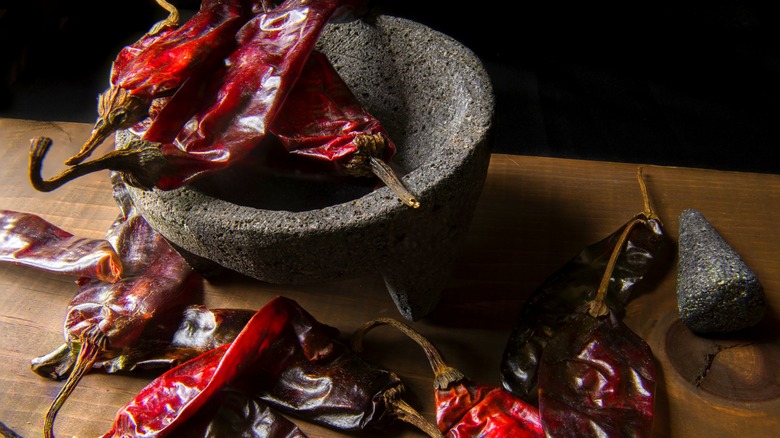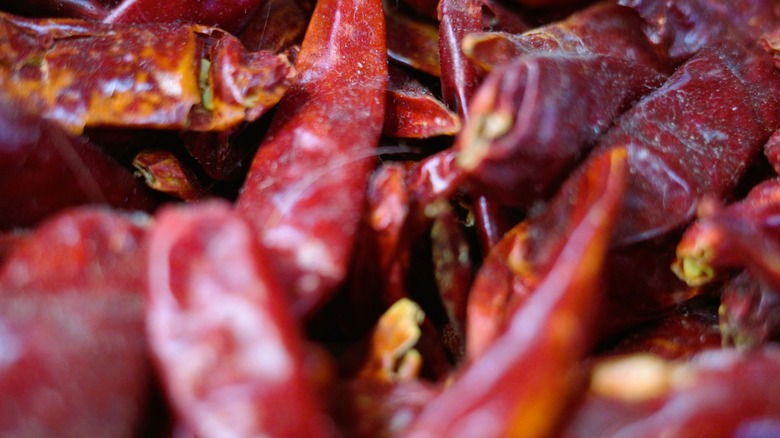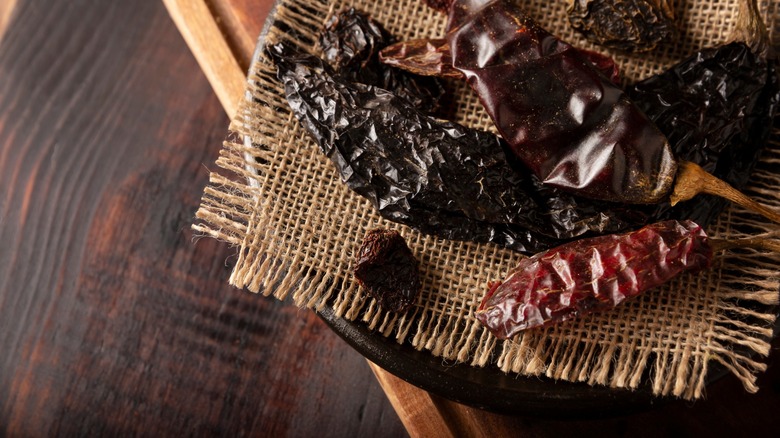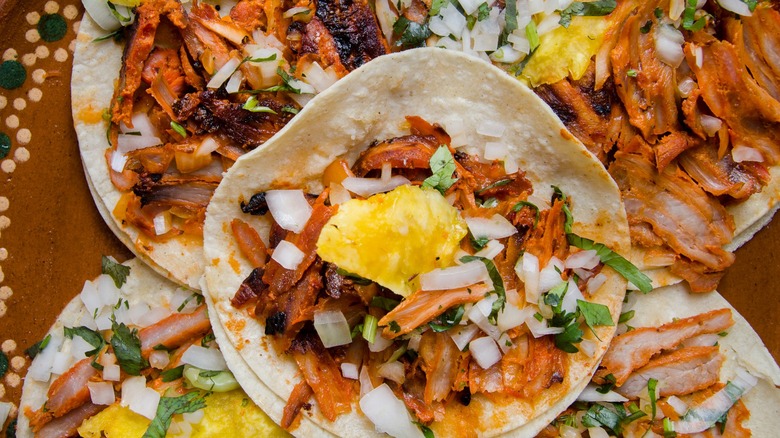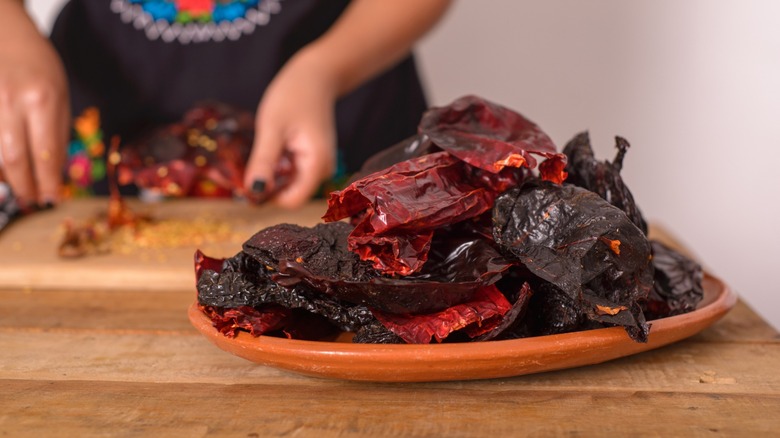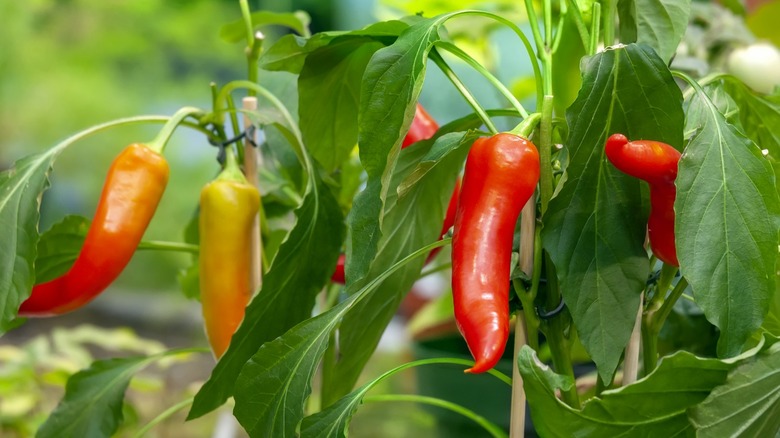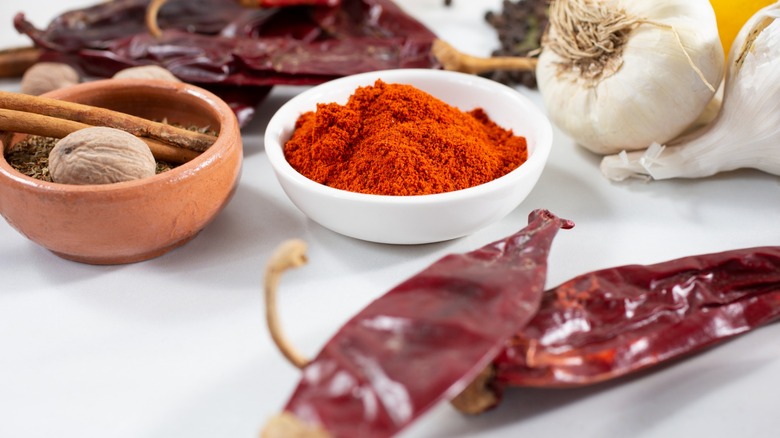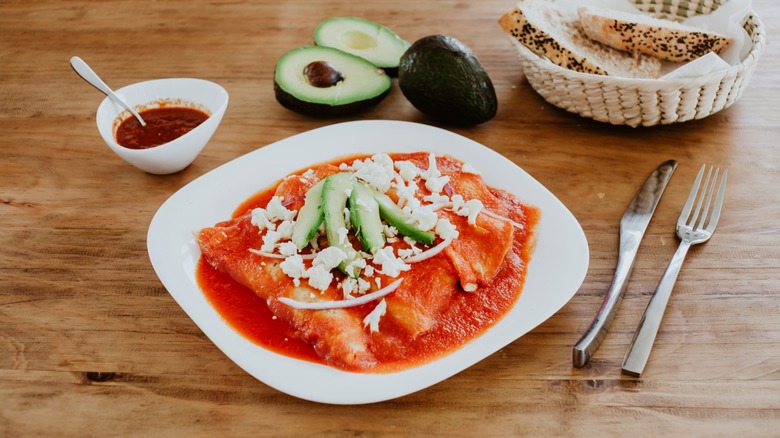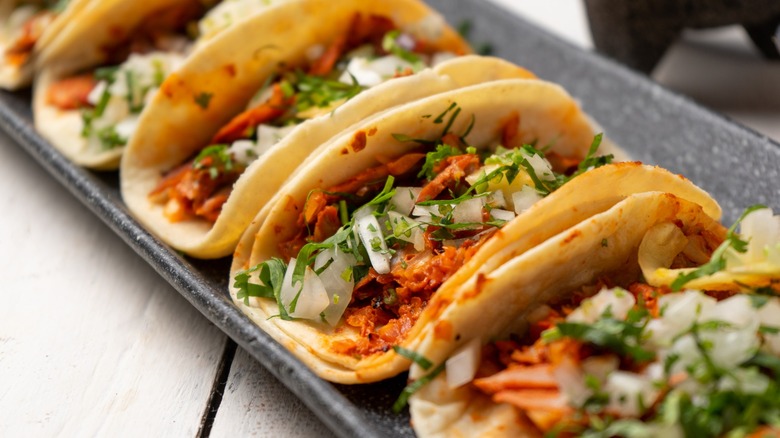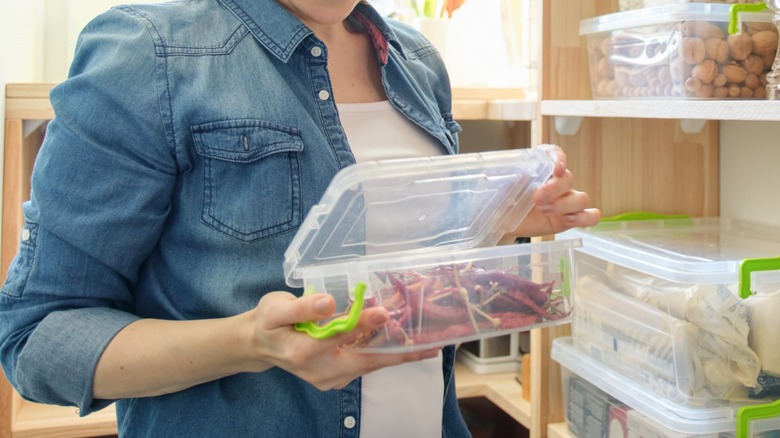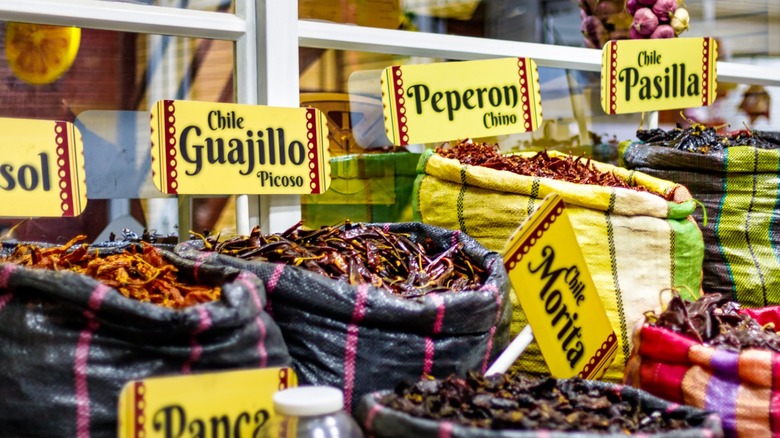What Are Guajillo Chiles And What's The Best Way To Cook With Them?
We may receive a commission on purchases made from links.
All prices listed are as of the date of publication and may differ based on region.
Mexican chiles and spices have utility beyond regional dishes. These dried chiles add the right amount of kick to just about any bland food. There are so many varieties to explore, including some peppers that will set your mouth on fire, so how do you choose the best one?
The most flexible peppers add a bit of heat and unique flavor to your dish. That's where guajillo chiles (Capsicum annuum) come in. These chiles, which are a staple in Mexican cuisine, have a medium amount of heat compared to other peppers and register a score between 2,500 and 5,000 on the Scoville heat scale. This unit of measurement calculates the concentration of capsaicin, a chemical that gives the fiery flavor to peppers and chiles. The scale runs from zero for bell peppers to over 2 million for the hottest: Pepper X.
Guajillo's score lies right around jalapeños and chipotle peppers, making it an ideal choice for cooking for those seeking a mild pepper with a slight bite. We've done all the research around this little pepper to help you decide if it will be a good fit for you to use in Mexican recipes and beyond.
What are guajillo chiles?
Guajillo, pronounced "gwah-HEE-yo," chiles hail from Mexico and are commonly used in the country's cuisine. These peppers, which are almost always found dried, have a sweet and smoky flavor that adds both heat and complexity to your recipes. The sweetness of the pepper has a berry or green tea-like undertone. Its unique taste gives the guajillo a similar popularity to the ancho pepper.
Guajillo chiles come from drying marisol peppers. In Spanish, marisol translates to "looking at the sun," which also describes the upward growth of the plants. Its cone-shaped fruits are about 2 to 3 inches long and bright red. Once dried, guajillo peppers take on a wrinkly, brown appearance.
You'll find two varieties of guajillo chiles available on the market. Guajillo puya is smaller in size and more concentrated in both flavor and heat, while the standard guajillo chile has a more robust profile and a more mellow spiciness.
The origin of guajillo chiles
The history of these chile peppers dates back thousands of years ago. Guajillo chiles were originally found in the north-central region of Mexico. The Aztecs called the peppers huaxin and labeled them sacred, with potential applications in both food and medicine. Guajillos remained in the country until the 16th century when the Spanish conquered Mexico. This led to the diffusion of the peppers past the borders of Central America and out into the rest of the world.
Guajillo chiles also go by different names depending on the region in which they are grown or sold. For example, the state of Mexico calls the guajillo the red chilaca chile, while in San Luis Potosi, it goes by the three veins chile. Colima sells Cualachero chiles, and the state of Jalisco calls both dried and fresh varieties mirasol. While several states in Mexico claim to be the primary producer of guajillo chiles, the state of Chihuahua is well-known for its massive exports to other locales in Mexico and beyond the country's borders.
Are guajillo chiles nutritious?
Guajillo chiles can be an excellent, flavorful addition to your dish. While the peppers do not have extensive nutritional value in terms of macronutrients like protein and carbohydrates, they contain some trace amounts of vitamins and minerals like iron, calcium, and potassium. Granted, since peppers are consumed in such small quantities, it's unlikely that eating them as a seasoning on meat or in a sauce would provide a significant amount of these micronutrients and subsequently alter health outcomes.
Today's varieties of guajillo chiles are all non-GMO, which means they are not genetically modified. Experimentation has been done in this area, but genetically modified guajillos have not been released onto the market. You'll also find mostly conventionally-grown peppers rather than those with organic certification. Organic guajillo is more difficult to find because while many farmers use organic practices and limit the use of things like pesticides, they cannot afford the official certification that would allow them to market their peppers as such.
Precautions to take when cooking guajillo chiles
Buying guajillo chiles requires just a little finesse. For the best results for cooking, buy the peppers when the skin is smooth and shiny, and the fruit can easily move between your hands. If the chiles are firm and cracked, it means it is no longer fresh. Although it's still usable, it will have less flavor than a fresh one. You'll also want to be sure to avoid burning your guajillo chiles when you cook them. Otherwise, you'll release a pungent flavor that can ruin your dish.
Most guajillo chiles are medium heat, but this may be relative to the person eating them. For example, guajillos have a similar or slightly milder heat than jalapeños. Jalapeños have a higher heat range, from 2,500 to 8,000 Scoville Heat Units (SHUs), while guajillo chiles top out at 5,000 SHUs. And those numbers pale compared to Mexico's most popular pepper, the ancho, which ranges from 1,000 to 1,500 SHUs. The heat from guajillo chiles should not be an issue to anyone who enjoys a little kick in their food.
How to grow guajillo chiles
Growing marisol peppers for dried guajillo chiles is surprisingly easy. These plants require little attention by way of daily care, but need certain conditions to thrive. That said, if you've ever had success growing peppers, the plant is relatively easy to grow. This pepper plant will reach about 2 to 3 feet tall, and the peppers can grow as long as 5 inches but typically remain in the 2 to 3-inch range when they're ready to harvest.
These plants thrive in soil that is well-drained, rich in nutrients, located where it can get six to eight hours of sunlight daily, and has a pH between 6.3 and 6.8. Due to the plant's small size, you can grow it in a container or in your garden. Ideally, you'll want to plant the seeds about six or eight weeks before frost conditions end. Germination takes about a week, and once you see two sets of leaves, you can transplant them into temperatures above 70 F. Handle pests with neem oil spray or rubbing alcohol, and use a fungicide if necessary.
Mirasol peppers require 60 to 80 days to mature but don't be too impatient to harvest them. The longer you keep the peppers on the plant, the hotter and richer the flavor will be. Once picked, place the whole peppers on a mesh screen in a dry area for about two weeks.
Dried vs powdered guajillo chile
Guajillo chiles are, by definition, the dried version of marisol peppers. However, this spice is also available in powdered form. You can buy commercially available guajillo pepper powder, also called marisol chile pepper powder.
You can make your own powder if you dry the pepper yourself. After removing the stems and the seeds, toast the chiles in a pan and press them to release their flavor. This technique is best done with a few chiles at a time. Completely cool the peppers before adding them to a coffee grinder and pulse until powdery.
Marisol chile pepper powder may not offer the same experience as the dried chiles in your dish, but it is far more convenient to use. You can add it to spices to create a more complex spice blend, like one you may already have already tried: Harissa seasoning. This Mediterranean spice blend is popular as a seasoning or flavoring agent in soups and stews.
How to prepare guajillo chiles for cooking
Guajillo chiles require some preparation before cooking. One of the most common techniques to get the peppers ready to go is to first rehydrate them. Simply cut and remove the stems and seeds, then toast them on each side in a preheated pan over a medium flame for about 10 to 15 seconds. Ensure they don't burn, or your dish will have undesirable, acrid flavors. Once done, put them in a bowl of hot water for 20-30 minutes. The exact length of this process depends on how firm they were when purchased. The final result should be pliable peppers that are ready to be cooked with.
Add your rehydrated guajillo chiles to sauces, soups, and even brines. Or, you can blend them with other chiles, spices, and ingredients, like homemade Harissa sauce. One of our favorite ways to use this pepper is to make a homemade red enchilada sauce. This is an excellent topping for multiple dishes, including a family-fun recipe like Mexican pizza.
How to use guajillo chiles for Mexican recipes
Naturally, guajillo chiles are best suited for Mexican food. Their medium heat is ideal for many traditional meals. Recipes that are perfect for this chile pepper include pozole rojo, a classic Mexican soup, homemade chorizo, red pepper sauce, tortilla soup, salsa, and empanada sauce. The chile is also commonly used for mole sauce.
Guajillo chiles combine well with other chiles, such as pasillas. Our Chile Colorado recipe calls for both dried chiles. Pasillas are also sweet, but the taste is closer to a raisin than the berry-like guajillo. Like guajillos, the pasilla also has an earthy flavor. The differences mean these two flavors complement each other, especially considering pasillas are lower on the Scoville scale.
One of our favorite uses of guajillo chile is in fried eggplant pambazos. To make a pambazo roll, soak day-old bread in guajillo-infused chile sauce. The bread must be hard and crusty to stand up to this process. The eggplant is pan-fried for a seriously guilty indulgence, which is suitable for vegetarians. Carnivores can also try the traditional preparation made with chorizo. Save this dish for a casual night since this carb-fest is a messy sandwich.
Another great recipe is tacos al pastor, which features pork and pineapple. The pork is marinated in chile peppers for several hours to infuse flavor into the meat. While there are other chile choices, the guajillo's sweet and smoky flavor is an ideal match for this sweet and savory dish.
Substituting other chiles with guajllos
No pepper is irreplaceable, but guajillo chiles are unique enough that if you like them in a dish, you will be hard-pressed to find a good substitution. Their fruity essence does set them apart, but there are some other options you can try if you can't get your hands on the guajillo.
Since it lies in the middle of the heat scale, you can match heat intensity when replacing guajillo chiles in a recipe. First, try dried New Mexico chiles. They are also fruity and somewhat close in flavor, so you can make a one-for-one substitution. Prepare these just as you would guajillo peppers. Next, you can use one of the most popular Mexican peppers: the ancho. The variety should be readily available in supermarkets or ethnic stores. Like the New Mexico chiles, this is a one-for-one substitution with the same preparation. However, ancho chiles are smokier than guajillos, so you may want to rebalance the recipe by adding another pepper variety.
The next best options are pasilla chiles. To make this substitution work, you'll also need to add ½ teaspoon of white vinegar for every six chiles you use to help amp up the acidity.
Creative ways to use guajillo chiles outside of Mexican dishes
Although well-suited for Mexican dishes, these chiles can also be used for recipes outside of the region. For example, you can use them to season a pasta dish or lend heat to grilled shrimp. You can also create a peppery guajillo sauce to shake up your meatball recipes.
Traditional Mexican pambazo sandwiches aren't the only sandy that can benefit from these peppers. We think this seasoning would be a great addition to meat or chicken-based sandwiches that need a little bit of heat and sweetness. For example, spicy guajillo sauce will go well on a cheeseburger. You can also add it to short ribs before serving them or over mac and cheese for a decadent take on an American dish.
One of the most interesting ways to use guajillo powder is in dessert. That's right. You can serve this spice on ice cream or dust it over strawberry cheesecake. Its berry underpinnings make it ideal for desserts complemented by a bit of heat, like recipes that call for Mexican chocolate.
How to store guajillo chiles and powders
Guajillo chiles and seasoning have a long shelf life when stored properly. Dried guajillo can last up to two years when protected from sunlight, water, and humidity.
Use an airtight container for the best storage results, and check the peppers every few weeks to ensure they have not succumbed to mold or pests. If they have damage, smell funny, or are too soft, you should throw them out. Even if you do store them properly, they taste best if you use them within six months of opening the original container.
The powdered version can last two to four years when stored away from light, heat, and moisture. In contrast, dried flakes can last up to three years. The storage conditions will drastically influence how long the peppers are good for.
When drying marisol peppers, you can slice them to speed up the process, but the whole peppers bring a richer flavor to your dish. A food dehydrator will make the process much faster, plus, you won't have to worry about rainy days or sacrificing the flavor of your pepper.
Where to buy guajillo chiles and powders
Guajillo chiles and marisol chile powder are not widely available at most supermarket chains but can be found in Mexican markets and stores throughout the U.S. If you live in an area with a large Mexican population, however, you may be able to find them in local grocery stores or larger merchants like Whole Foods. We recommend checking the produce aisle for the chiles and the ethnic foods aisle for the seasoning. When buying dried chiles, look for products that are bright in color and supple to the touch. Avoid any that have small holes, which may be caused by pests. If you cannot find the whole peppers or the powder, we recommend looking for products that contain the chiles, like Trader Joe's guajillo salsa.
Purchase RicoRico dried guajillo chiles (16-ounce) on Amazon for $15.22.
Purchase Herdez guajillo pepper paste (7-ounce) on MexGrocer for $7.95.
Purchase D'allesandro guajillo chile powder (18-ounce) on Amazon for $9.90.
